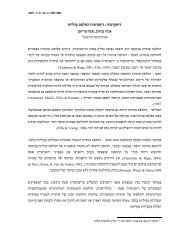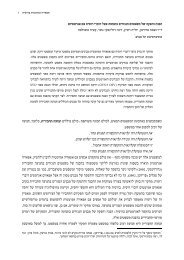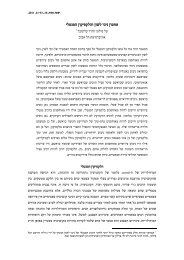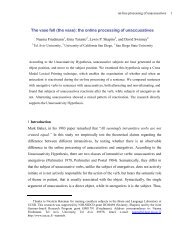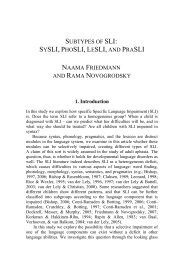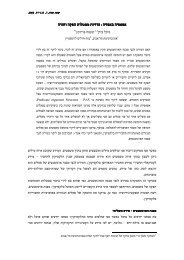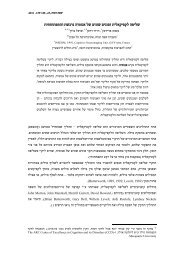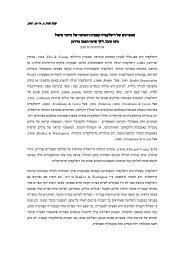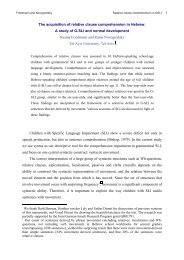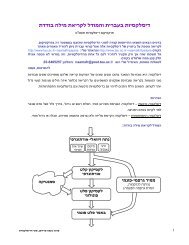Developmental surface dyslexias - Naama Friedmann
Developmental surface dyslexias - Naama Friedmann
Developmental surface dyslexias - Naama Friedmann
You also want an ePaper? Increase the reach of your titles
YUMPU automatically turns print PDFs into web optimized ePapers that Google loves.
cortex 44 (2008) 1146–1160 1157<br />
susceptibility of potentiophones to reading errors results<br />
from the fact that when a reader reads a potentiophone<br />
via the sublexical route incorrectly, she cannot know that<br />
she has made an error because the result is another existing<br />
word (for the effect of frequency and regularity on potentiophone<br />
errors see Lukov and <strong>Friedmann</strong>, 2006). Potentiophones<br />
are especially helpful in the detection of <strong>surface</strong><br />
dyslexia, because errors cannot be detected and corrected<br />
by the reader, and because, unlike homophones, even reading<br />
aloud can already indicate a deficit in reading via the<br />
lexical route. Homophones, on the other hand require additional<br />
comprehension tasks.<br />
The identification of subtypes of developmental <strong>surface</strong><br />
dyslexia is interesting and important not only for its theoretical<br />
implications. It also has immediate implications for<br />
diagnosis and treatment. With respect to diagnosis of developmental<br />
<strong>surface</strong> dyslexia, the current results suggest that it is<br />
not enough to detect that an individual reads via the sublexical<br />
route by assessing her performance in reading aloud.<br />
Tasks involving lexical decision and homophone/potentiophone<br />
comprehension are required to discover the exact locus<br />
of impairment in the reading process.<br />
The distinction between different loci that can cause reading<br />
via grapheme-to-phoneme conversion can also be used to<br />
discern developmental <strong>surface</strong> dyslexia from impoverished<br />
orthographic lexicon that results from limited exposure to<br />
reading. In many cases children with other types of dyslexia,<br />
such as peripheral <strong>dyslexias</strong>, avoid reading as much as they<br />
can (see Cunningham and Stanovich, 1998; Share, 1999; Stanovich,<br />
1986; Stanovich and West, 1989), and as a result do<br />
not establish a rich orthographic input lexicon. This, in<br />
turn, results in ‘‘<strong>surface</strong>-dyslexia-like’’ reading (<strong>Friedmann</strong><br />
and Gvion, 2002; <strong>Friedmann</strong> and Nachman-Katz, 2004; <strong>Friedmann</strong><br />
and Rahamim, 2007; Nachman-Katz and <strong>Friedmann</strong>,<br />
2007; Rahamim and <strong>Friedmann</strong>, in press). The administration<br />
of lexical decision and homophone comprehension tasks in<br />
addition to oral reading can help in determining whether<br />
the child has <strong>surface</strong> dyslexia or whether it is just an impoverished<br />
orthographic input lexicon secondary to another dyslexia.<br />
If the deficit is found to be located at the orthographic<br />
input lexicon, other ways will be needed to make the decision,<br />
but if the deficit is found to be located elsewhere, in<br />
the output of the orthographic input lexicon to the phonological<br />
output lexicon or to semantics, this will suggest that it is<br />
indeed a genuine <strong>surface</strong> dyslexia, and not a phenomenon<br />
secondary to reading avoidance.<br />
With respect to treatment, different treatment plans<br />
should be applied to the different subtypes of <strong>surface</strong> dyslexia<br />
– treatment for individuals with a deficit at the orthographic<br />
input lexicon should include improving the<br />
operation of this lexicon (see Coltheart and Byng, 1989;<br />
Weekes and Coltheart, 1996), and establishing robust lexical<br />
entries in this lexicon by means of mnemonics and repeated<br />
exposure for example. However, if the orthographic input<br />
lexicon is intact and functioning, the treatment should be directed<br />
elsewhere. For example, the work with individuals<br />
who have access to the orthographic input lexicon but cannot<br />
access the phonological output lexicon and semantics should<br />
be directed at improving these connections, and for individuals<br />
who have <strong>surface</strong> dysgraphia alongside this type of<br />
<strong>surface</strong> dyslexia, reading for monitoring of writing can be<br />
trained. For those individuals who read aloud incorrectly<br />
via the sublexical route but who understand words correctly<br />
via the route from the orthographic input lexicon to the semantic<br />
system, the advice should be – do not read aloud.<br />
To summarize, developmental <strong>surface</strong> dyslexia has several<br />
faces. The current study identified three groups of individuals<br />
who had different subtypes of developmental <strong>surface</strong> dyslexia.<br />
All subtypes resulted from an impaired lexical route,<br />
which forced reading via grapheme-to-phoneme conversion,<br />
causing difficulties in reading irregular words and potentiophones,<br />
but they differed with respect to the locus of impairment<br />
within the lexical route, and, as a result, in the<br />
manifestation of the deficit in lexical decision and<br />
comprehension.<br />
Acknowledgements<br />
This article is dedicated to the memory of John Marshall,<br />
who led the way in the classification of <strong>dyslexias</strong>, was the<br />
first to describe <strong>surface</strong> dyslexia in detail, and deeply believed<br />
that developmental <strong>dyslexias</strong> can and should be classified<br />
similarly to acquired <strong>dyslexias</strong>. Shalom, John. We<br />
thank Dror Dotan, Ivana Nachman-Katz, Julia Reznick,<br />
Maya Yachini, Michal Biran, Terri Sternberg, and Uri Hadar<br />
for their helpful comments on the paper. This research<br />
was supported by the Israel Science Foundation (grant no.<br />
1296/06, <strong>Friedmann</strong>).<br />
Appendix A<br />
Ambiguous grapheme–phoneme and<br />
phoneme–grapheme correspondences<br />
in Hebrew<br />
Ambi-phoneme letters in Hebrew<br />
Hebrew letter Phonemes Transcript<br />
ae(ø oi)’(glottal stop)<br />
A<br />
vb<br />
B<br />
aeø’<br />
H<br />
vuo<br />
O<br />
iy(a eei)<br />
I<br />
kx<br />
Q<br />
’ aea ?<br />
pf<br />
P<br />
ssh<br />
S<br />
Ambi-letter phonemes in Hebrew<br />
Phoneme Letters Transcript<br />
a<br />
’(glottal stop)<br />
v<br />
x<br />
t<br />
k<br />
s<br />
H?A<br />
H?A<br />
OB<br />
XQ<br />
Tt<br />
KQ<br />
Ss




